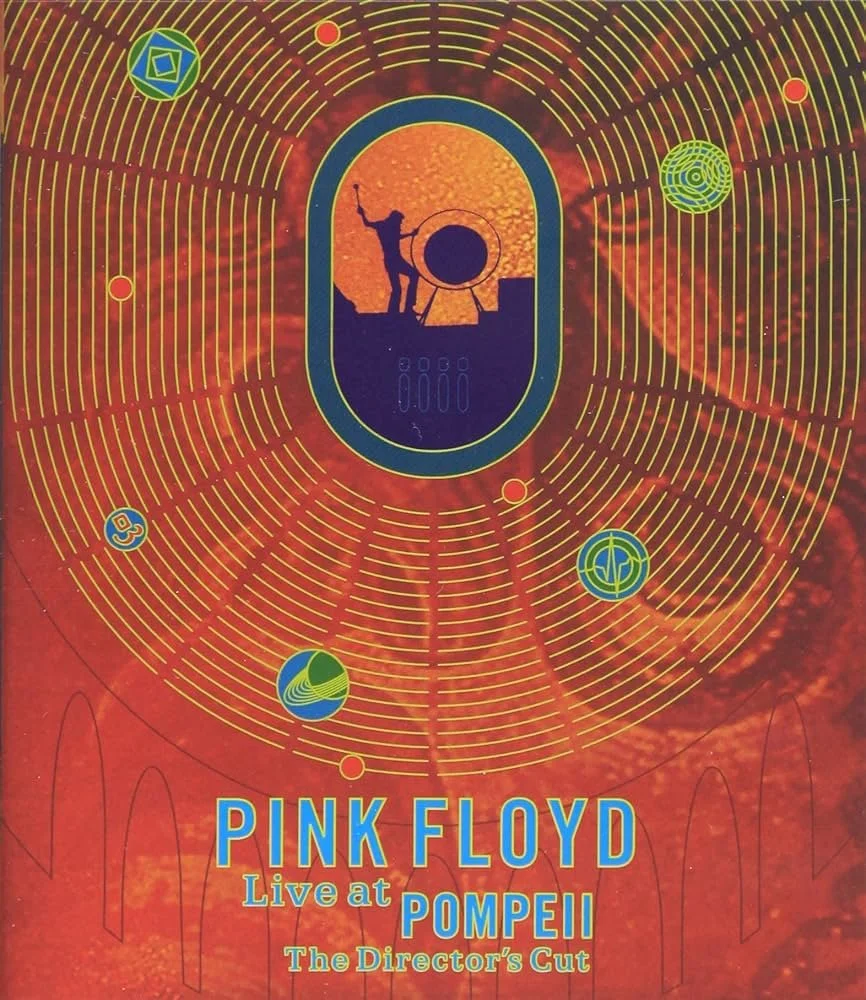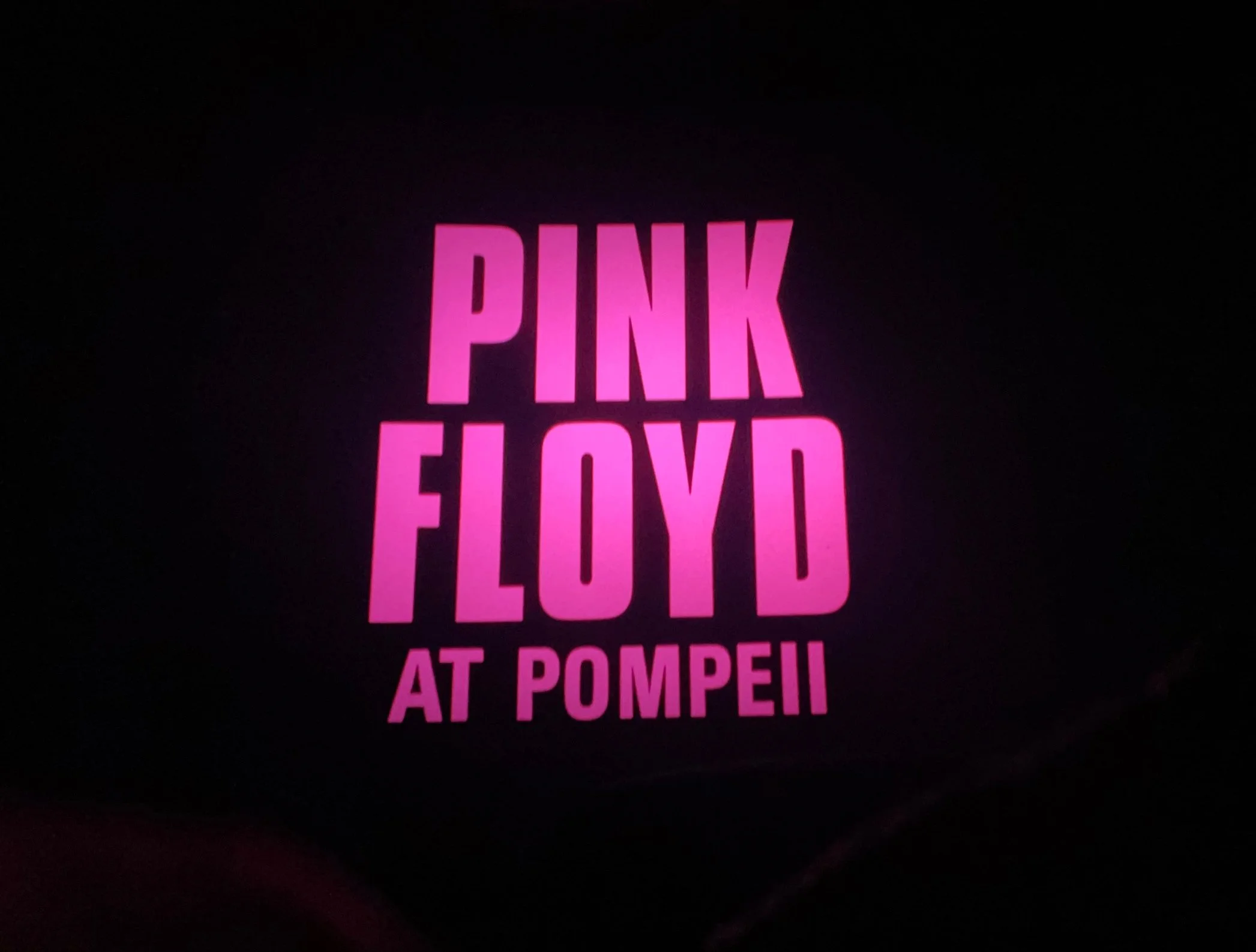Pink Floyd at Pompeii
Recently I had the pleasure of seeing Pink Floyd at Pompeii on the biggest screen on them all, in IMAX! It was a special two-night only screening of a new restoration of the 1972 film.
Saying that I was excited for this would be an understatement, as Pink Floyd at Pompeii is literally one of my favorite things ever. As a filmmaker and artist, I have studied this film closely and have been inspired by it endlessly; watching certain moments over and over again trying to reverse-engineer how it was shot.
Strictly from a filmmaking point of view and regardless of how you feel about their music, Pink Floyd at Pompeii is deeply intriguing in its creative choices to strip away pretty much anything resembling a live concert.
ABOUT THE FILM
As I often describe the film to those who haven't seen it, Pink Floyd plays live in the literal ruins of Pompeii to NO ONE. Although it's labeled a concert film, it's impossible to really call it that. The audience consists of the sound engineers and the filmmaking team, who are all right out in the open and therefor part of the the film.
Not that the size of the audience is what keeps this from being a traditional concert film, as it's not structured like a concert in any way.
Each song makes up a section of the film and every song is filmed & edited in a different style. It's almost as if each song is a music video that when combined, creates a concept album or concept film if you will.
DIFFERENT VERSIONS OF THE FILM
There are a couple of things worth noting here, as several versions of the film exist. The original film that was released in 1972 is strictly the concert, coming in at a little under 60 minutes. The film was thought to be too short, so in 1974 the film was re-released with footage of Pink Floyd in the studio experimenting on what would become Dark Side of the Moon. When the DVD was released in 2003 they created a "Director's Cut" version which includes a number of significant alterations to the film.
This is how the 2003 DVD describes the Director's Cut:
"Director Adrian Maben brings us a brand new version of the legendary film. In addition to the existing interviews shot during the 1972 recording of Dark Side of the Moon, this cut features unique, personal footage of the band working on "Live at Pompeii" in Paris, atmospheric space shots and a host of new visual effects."
The Director's Cut for me is my least favorite version. Upon first seeing it when the DVD was released, the digital animations of space already looked incredibly bad and dated. The footage of Pink Floyd in the studio cut along to them singing Echoes in the ruins of Pompeii really takes away the power of those shots, especially considering they left in shots of the band messing up during the recording.
Some of the other footage captured of them in-studio was interesting, but honestly would have worked better as a standalone little documentary, or even a special feature on the physical copy.
The cover of the 2003 DVD release
Not only are there different cuts of the film, with this restoration there's now a different title. For years it was known as Pink Floyd Live at Pompeii, but the restoration drops Live and instead calls it Pink Floyd at Pompeii. My guess is maybe so it wouldn't continue to be confused as a concert film? Either way I've always called it Live at Pompeii and catch myself continuing to do so out of habit. So if you ever hear me talk about this film in person, that's what I'm likely to call it.
The version presented at this screening was the 1974 version, mixing the live concert and the footage of the band inside the studio during the recording of Dark Side of the Moon, which is the best version of the film. Although sometimes it's nice to just throw on the original concert version, especially if it's on in the background, and then just straight up groove with the music. But as a documentary it works much better with the studio footage.
THE RESTORATION
Lana Topham, the film's director of restoration, had been searching for the original rushes and camera negatives since 1994, after being asked by Pink Floyd guitarist David Gilmour to find unedited footage from the Pompeii shoot. This started an obsessive journey for Lana that lasted decades, looking through every possible storage facility and film lab in France & Great Britain. Every location turned up nothing. But persistence eventually paid off, and in 2020 film cans labeled "Pompeii" were discovered in a London storage facility, containing materials that once belonged to David Gilmour. This storage facility was unknowingly home to 35mm camera negatives from the first cut of Pink Floyd's seminal concert film. Although not the raw unedited footage they were seeking, it was by far the best source known to man. After a 26-year quest, they had found what they needed to create a restored version of the film!
For the restoration, the 35mm camera negatives were scanned and converted into glorious 4k video. Both the image and audio were restored and enhanced for the modern theatrical experience, in the best possible way. They kept the original 4:3 aspect ratio and did not stretch it to fit modern theatrical screens, which I was happy to see that they preserved the original presentation of the film.
As someone who has watched this film on many formats from DVD, VHS & even CED!, this version blows everything else out of the water. It looked and sounded as close as you can get to perfect. It definitely ranks up there with one my favorite experiences of all time in a movie theater. I couldn't have enjoyed it more!
If you missed the film or would like to check it out again, the restoration has been released on DVD & Blu-Ray, and for the first time EVER, an official soundtrack has been released!
THE SCREENING
The opening moments of the film are set to total blackness with nothing but the sound of a heartbeat. Hearing a newly remixed and remastered soundtrack in 6-channel audio with 44 speakers was intense.
Though I love pretty much every second of this film, my favorite part happens in the first song. The movie begins and closes with Echoes, a 25-minute song broken up into two parts, serving as perfect bookends to the film.
The entirety of Echoes, for me, is profound; but there's one moment that stands above the rest. It happens after the band really starts to get into it during Echoes Part 1, during the groovy section after David Gilmour's guitar solo. It cuts to a tracking shot of a camera moving behind the amps, which all have "Pink Floyd London" stenciled in white lettering on the back. The shot reveals the band from behind, while also capturing the film crew and sound engineers, all set against a sweeping and towering arena of ruins. The sun casting long shadows across the area where spectators once watched gladiators and public executions.
Something about this part of the film NEVER fails to get me going. It's shot and edited perfectly. That smooth long shot from behind the amps and behind the band, moving in sync with the music, might be my favorite camera shot of all time.
And the music could not be better. Nick Mason is such an insanely talented drummer that it makes you want to become a drummer! Echoes and Nick Mason's drumming were always the two things that stood out to me the most in this film. I also love the experimental and artistic editing they played around with to diversify the way you can show a band playing music live. All around deeply creative and experimental. It makes tons of sense that they went right from making this into creating Dark Side of the Moon.
I was extremely impressed in the quality of the image, which is understandable going from a 20+ year old DVD to a 4K Restoration in IMAX. But overall they created a gorgeous print that will look amazing on any screen.
Pink Floyd Live at Pompeii was made during the creative height of one of the most trailblazing bands in history. Aside from fans of Pink Floyd, I think this is an important film for filmmakers to watch. It's well-made and has tons of cool ideas going on all at the same time. This restoration assures that the film will be available in a practically perfect version for at least the next 50 years. Absolutely worth checking out even if you've seen it, because the restoration really is what the film needed to be all this time. If you've never seen the film then you're in for one insane treat!
RATING - 5 out of 5 Stars




